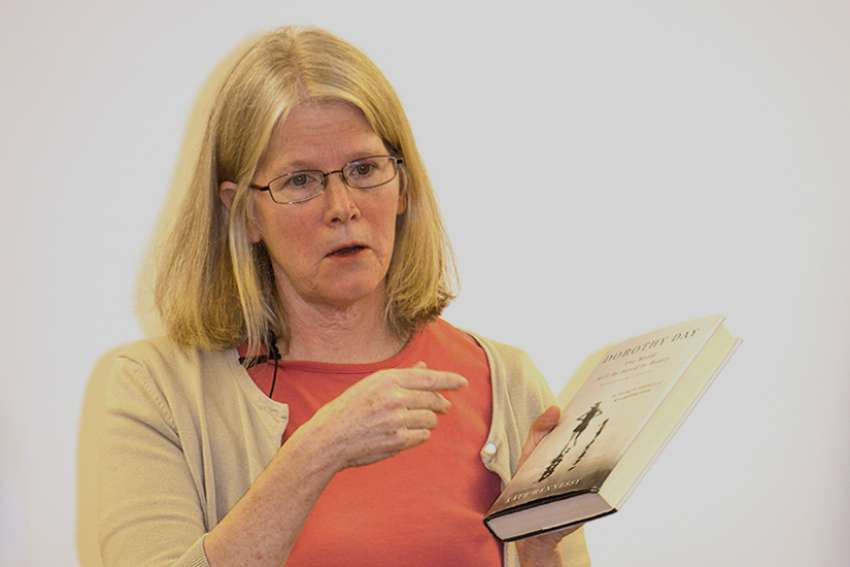“It took a lot out of me,” admitted Kate Hennessy. She took seven years to build a memoir of her grandmother, who is possibly the 20th century’s most contentious cause for sainthood — Dorothy Day.
“There are a lot of wounds in this story,” said Hennessy as she brought her new book on Day, The World Will be Saved by Beauty, to the Mary Ward Centre in Toronto on Nov. 2. “I was making public some pretty painful parts of my family. On the one hand she was my grandmother. On the other hand, she was fierce.”
 Day, born in 1897, began her career as a journalist for New York socialist publications The Liberator, The Call and The Masses. She quickly transitioned from journalist to activist and was arrested while protesting in Washington, D.C., demanding the vote for women. In jail, she was beaten.
Day, born in 1897, began her career as a journalist for New York socialist publications The Liberator, The Call and The Masses. She quickly transitioned from journalist to activist and was arrested while protesting in Washington, D.C., demanding the vote for women. In jail, she was beaten.
Her Greenwich Village circle included idealists who rejected the decadence of the 1920s by turning to communism. She had a long, unhappy, passionate love affair with the communist writer Mike Gold and another with journalist Lionel Moise. When she became pregnant by Moise she attempted suicide, obtained a back-street abortion that nearly killed her and attempted suicide again.
It was her friendship with the great American playwright Eugene O’Neill that got her asking spiritual questions. It was her own foray into literature — a novel called The Eleventh Virgin — that won for her the safe haven of a seaside cottage on Staten Island.
Day began to wander into Manhattan churches, asking herself spiritual questions and learning to pray.
After her abortion, Day thought she could never have children but was surprised with the birth of her daughter Tamar. With the help of Sr. Aloysia of the Sisters of Charity, Day — who was not yet baptized herself — had Tamar baptized to the dismay of her disbelieving husband Berkeley Tobey.
By the time Tamar was six, Day had met French Catholic intellectual and social reformer Peter Maurin. The Catholic Worker movement was born — first in the form of a newspaper in 1933, then a soup kitchen, then in a sort of loose form of co-operative, common life movement called Houses of Hospitality. It is a community committed to “non-violence, voluntary poverty and the Works of Mercy.”
Born ninth of Tamar’s nine children, this chain of motherhood from Dorothy Day to Tamar Theresa Hennessy to herself has been Hennessy’s spiritual, biological, social and literary legacy.
Writing about her revered and legendary grandmother “took a lot of work and energy,” Hennessy said.
“Her life never stopped. She never stopped. Her energy never stopped,” said Hennessy, whose book gets its title from one of Day’s favourite Fyodor Dostoyevsky quotes.
Day opened Mary House in Manhattan’s East Village when she was 79 years old. It was the Catholic Worker community where she died three years later in 1980. Getting the details right about a life so filled with newspapering, picket lines, arrests and causes is complicated enough, but writing a book that can live up to Day’s own vocation as a writer and the expectations of millions of Catholics who revere Day was daunting, Hennessy said.
In his 2015 speech to the United States Congress, Pope Francis urged lawmakers to remember four American heroes who lived their nation’s ideals — Abraham Lincoln, Martin Luther King, Thomas Merton and Dorothy Day. The Pope’s mention of Day added fuel to her cause for sainthood, which the U.S. bishops unanimously endorsed in 2012.
The idea that Day was a reckless iconoclast wielding Catholicism as a political weapon just doesn’t stand up to any serious examination of her life, according to Hennessy.
“She had an incredible love for the Church. She didn’t believe in confrontation. We have had enough confrontation,” she said.


